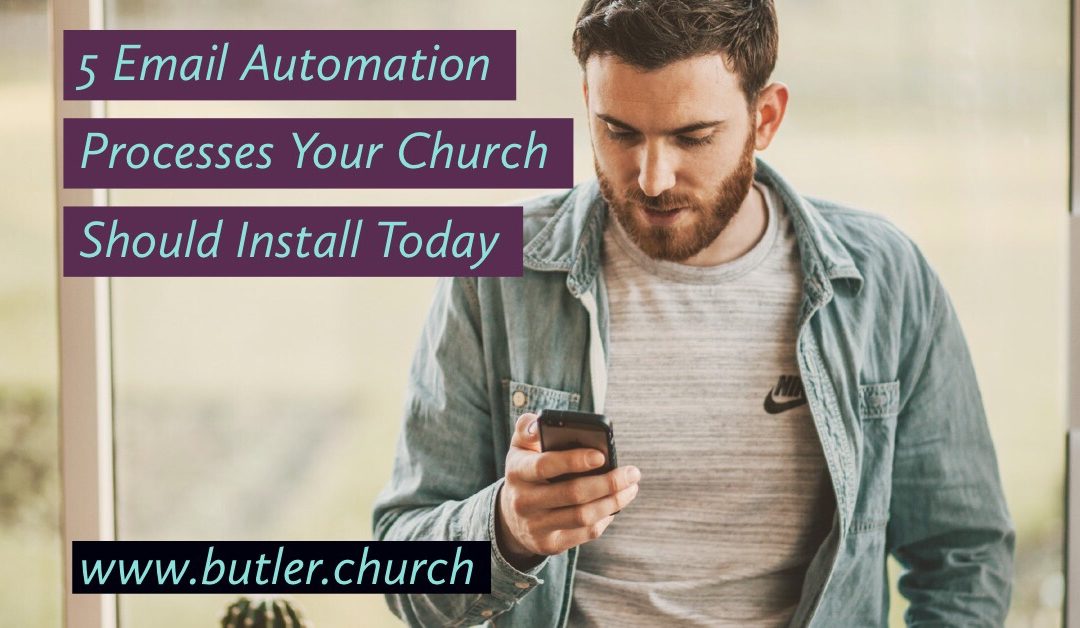Most churches are using some sort of email marketing platform.
Perhaps you are using it for your weekly newsletter. Or special event notices. Or emails from the senior pastor periodically.
But one of the most powerful features that you are already paying for his email automation features. Email auto responders. Pre-programmed email sequences. Etc.If you are not taking advantage of this side of your email marketing platform, you are missing out on huge opportunities to help your ministry flourish.
Here are 5 Email Automation Processes Your Church Should Install Today:
1. Happy birthday sequences.
Everybody likes being recognized on their birthday. It is the obligatory behavior to say happy birthday when Facebook prompts you regarding your friends’ birthday. It’s so ubiquitous that it has lost its real social value in the relationship.
But sending a personalized email on or even the day before is something that will stand out. This is an easy process where anybody gets put into the database with their email address and birth day and put it.
Next your job is to simply come up with a dozen different unique and creative Happy Birthday messages.
Remember you could use the function to insert variables like first name into your email text. (And don’t forget subject line!).
By pre-writing a bunch of different messages, you will avoid sending the same message multiple years in a row to any person on the list! Easy-peasy.
have seen examples where people include fun happy birthday videos embedded in the email. Or offering the birthday person to take them out for coffee and include a link to an appointment scheduling widget like Calend.ly, TimeTrade, etc.
2. First-time visitor welcome series.
If you have a connection card or a first time visitor form, etc. you are collecting contact information on a regular basis.
By pre-writing a series of emails that are geared toward developing the relationship, educating them about the church, inviting them to future opportunities, you have the ability to use technology to see all the personal relationship.
For some churches we work with, we have produced a full year’s worth of follow-up emails to send a first time visitor to the church. You can see a sample here.
3. First-time giver sequence.
The first time someone goes to your ministry is a big deal. They have made a choice that is not frivolous. You need to appreciate and recognize that both immediately and long-term.
Writing a series of emails that helps increase the confidence for the decision they made will help cultivate reoccurring givers.
This is the chance to help set the culture of generosity with the people who choose to give to your church. It’s a chance to put on display the work of the church outside the walls of your building. It’s a chance to recognize that your church and ministry would not be able to happen without their partnership and support.
4. Topical devotional series.
If you have the time and energy to personally disciple every person that comes to the doors of the church I’m sure that you would jump at that opportunity. However that just isn’t practical.
A very small step can be to curate a series of life–serving inspirational spiritual content such as a mini devotional sent around a topic.
Think about the felt needs in your community.
Think about common issues and topics that come up.
Think about sub-segments of your community population.
Once you set up a devotional sequence, you have the ability to refer to it on an ongoing basis in the future. Whenever the need/relevance arises, you can send people that way so that they get immersed in the devotional series.
5. Staff DNA email sequence.
Weather you use it as you bring in new hires to your staff now and in the future, or use this before all the current members on your team, the staff DNA sequence can be critical in helping to set vision, shape culture, etc.
Consistency of training and communicating vision is always an issue when you’re managing teams.
Being able to parse out the different pillars of the core DNA of your church. Sharing and explaining each one in a separate email will free you up to focus on relational one-on-one type things vs sharing the same fundamentals over and over again.

There you go! Five must-have email sequences.
Hope that helps kickstart your brainstorming for how to use the email automation function of your platform that you already use day in and day out.
Almost always, more communication and more transparency will help support a healthy team culture and atmosphere.
Employing the consistency that automation provides will ensure that everyone is on the same page, no one gets left out, and there are no gaps in dissemination of core information.
What other email automation topics and uses have you seen work well?
p.s. Have you thought about FIRST TIME VISITOR EMAIL SEQUENCES?


Recent Comments